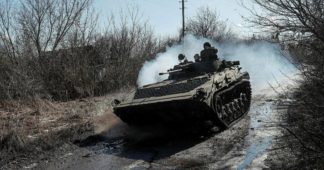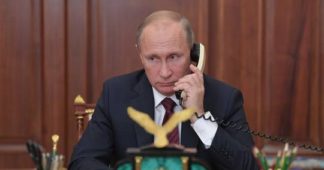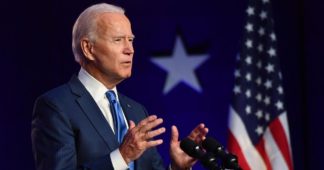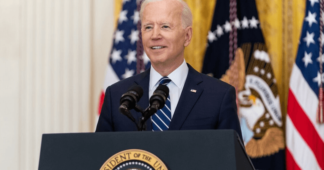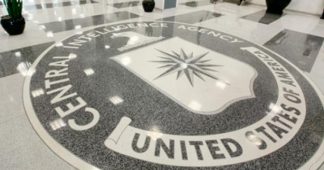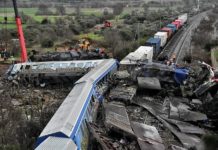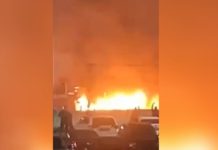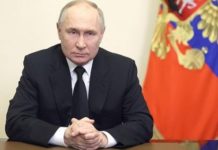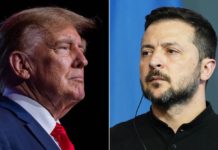February 23, 2022
Russian President Vladimir Putin’s decision to order troops into the separatist-controlled areas of Ukraine has triggered a new wave of sanctions against Russia, amid fears the situation could spiral into an all-out war. We speak with Dr. Ira Helfand, former president of International Physicians for the Prevention of Nuclear War, who warns a war could lead to the use of nuclear weapons that would annihilate millions and cause total collapse of world ecosystems. “We have found it almost impossible to imagine, 30 years after the end of the Cold War, that there could be a nuclear war between the United States and Russia, but the crisis in Ukraine is putting exactly that possibility on the table again,” says Helfand.
Transcript
AMY GOODMAN: President Biden has denounced what he called the “beginning of a Russian invasion of Ukraine,” after Russian President Vladimir Putin ordered troops into two separatist regions of eastern Ukraine while recognizing the areas as independent states. During a speech at the White House, Biden announced new sanctions against Russia and criticized Putin’s actions.
PRESIDENT JOE BIDEN: He’s setting up a rationale to take more territory by force, in my view. And if we listen to his speech last night — and many of you did, I know — he’s — he’s setting up a rationale to go much further. This is the beginning of a Russian invasion of Ukraine, as he indicated and asked permission to be able to do from his Duma.
AMY GOODMAN: It remains unclear if Russian troops have actually entered he Donbas region of eastern Ukraine, where 14,000 people have died over the past eight years in fighting between pro-Russian separatists and Ukrainian forces. Putin has defended his decision to order troops into the separatist-controlled areas, claiming they were needed for, quote, “peacekeeping.” But U.N. Secretary-General António Guterres blasted Russia’s rationale.
SECRETARY–GENERAL ANTÓNIO GUTERRES: When troops of one country enter the territory of another country without its consent, they are not impartial peacekeepers. They are not peacekeepers at all.
AMY GOODMAN: On the diplomatic front, Secretary of State Antony Blinken has canceled talks scheduled for tomorrow with Russian Foreign Minister Sergey Lavrov. Meanwhile, Ukraine has declared a state of emergency and urged all its citizens to leave Russia, where as many as 3 million Ukrainians live. This comes as the United States has announced plans to move 800 U.S. soldiers to the Baltics, along with eight F-35 strike fighters and 20 Apache attack helicopters. Another 12 U.S. Apache attack helicopters are heading to Poland.
As the prospect of a broader war increases, we turn now to look at an issue seldom discussed in the corporate media. Could the conflict over Ukraine lead to a nuclear war?
We’re joined now by Dr. Ira Helfand, the immediate past president of the International Physicians for the Prevention of Nuclear War, recipient of the 1985 Nobel Peace Prize. He’s also co-founder and past president of Physicians for Social Responsibility and serves on the international steering group of the International Campaign to Abolish Nuclear Weapons, which won the Nobel Peace Prize in 2017. His article “Ukraine and the Threat of Nuclear War” was recently published in The Nation.
Dr. Helfand, welcome to Democracy Now! Just address this issue. Can you talk about what is at stake?
DR. IRA HELFAND: Good morning, Amy.
And, yeah, there’s a whole lot at stake, unfortunately. We have found it almost impossible to imagine, 30 years after the end of the Cold War, that there could be a nuclear war between the United States and Russia, but the crisis in Ukraine is putting exactly that possibility on the table again. If the conflict there spreads, if NATO and Russia get drawn into active combat, both of these blocs have in their military doctrine provision for the use of military weapons if things are not going well in a conventional war. And we have to understand that as long as nuclear weapons are on the table in this way, it is possible they will be used.
The consequences would be absolutely catastrophic. If even a single 100-kiloton bomb was detonated over the Kremlin, a quarter of a million people would die; was detonated over Washington, over the Capitol, 100,000 people would die — 170,000 people. Hundreds of thousands of people would be injured, overwhelming the ability of local hospitals to take care of these patients. But if we escalate to the use of nuclear weapons, it is not likely that a single bomb would be used on a single city on each side. Rather, it’s more likely that many cities in each country would be attacked with many nuclear weapons. And the studies that we have done, back as far back as 2003, show that if just 300 of the 1,500 strategic weapons that the Russians deploy at this moment — if just 300 of these weapons detonated over cities in the United States, 75 million to 100 million people would die in the first half-hour. The entire economic structure of the country would be destroyed. Everything that the population depends on to maintain itself — the internet, the electric grid, the public health system, the food distribution system — it would all be gone. The same thing would happen in Russia with a comparable U.S. attack on Russian cities. And these are just the direct effects, the immediate effects.
A war between the United States and Russia would be a worldwide climate disaster. Hundreds of millions — perhaps as much as 150 million tons of soot would be put into the upper atmosphere, blocking out the sun, dropping temperatures across the planet an average of 18 degrees Fahrenheit. In the interior regions of North America and Eurasia, temperatures would drop 45 to 50 degrees Fahrenheit. We haven’t seen temperatures on this planet that cold since the last ice age. And under these conditions, the ecosystems which have evolved in the last 10,000 years would collapse, food production would stop, and the vast majority of the human race would starve to death. This is what we’re facing. And this is the danger we’re going to be facing as long as we allow nuclear weapons to exist.
JUAN GONZÁLEZ: And, well, Dr. Helfand, isn’t implicit, in terms of what you’re saying, one of the reasons why President Biden has repeatedly said that he has no intention of sending American military into Ukraine in case there is an invasion? What’s your sense — Ukraine itself had nuclear weapons under the old Soviet Union. It gave up its nuclear weapons. What’s your sense of the likelihood of this potentially occurring, that Russia will decide at one point or another, or the United States — if you could talk about where are the U.S. nuclear weapons? Where are they stationed right now in terms of potential for use of them in case of a wider war?
DR. IRA HELFAND: Well, it’s impossible to put a number, a percent number, on what the likelihood is that this is going to happen. And hopefully it won’t happen. But Russia has today about 1,500 strategic warheads and about another 2,000 tactical warheads. The United States has about 1,500 strategic warheads and about 100 tactical warheads stationed in Europe. Britain has about 120 deployed nuclear warheads. France has about 280 deployed nuclear warheads. So there’s a lot of potentially inflammable material sitting on the battlefield.
We don’t know what’s going to happen in Ukraine. Part of the problem is just that. When a conflict starts, there’s what people refer to commonly as the fog of war. Planning that was put in place before the conflict often becomes irrelevant. People lose contact with military units. Unexpected things happen. And we just don’t know how a conflict would play out. I think, as you mentioned, President Biden has appropriately indicated that the U.S. would not plan to send military troops into Ukraine in response to a Russian invasion, but that does not mean that we are foolproofed against an escalation of this conflict, because there are so many things that can go wrong once a war starts, as we saw in Ukraine — excuse me, as we saw in Iraq, that the war plan that the U.S. had sketched out before the conflict was not what happened. Totally unpredicted things, from the U.S. point of view, occurred. And the same thing can happen in a conflict in Ukraine.
AMY GOODMAN: Earlier this month, on February 8th, Russian President Vladimir Putin warned nuclear war would become more likely if Ukraine joined NATO. This is what he said.
PRESIDENT VLADIMIR PUTIN: [translated] I want to stress this one more time. I’ve been saying it, but I very much want you to finally hear me and deliver it to your audiences in print, TV and online. Do you realize that if Ukraine joins NATO and decides to take Crimea back through military means, the European countries will automatically get drawn into a military conflict with Russia? Of course, NATO’s united potential and that of Russia are incomparable. We understand that. But we also understand that Russia is one of the world’s leading nuclear powers and is superior to many of those countries in terms of the number of modern nuclear force components. There will be no winners.
JUAN GONZÁLEZ: What about that statement by President Putin, in essence, alerting the other side, the United States and NATO, of the potential for a conflict like this to spiral out of control?
DR. IRA HELFAND: Well, the last point that he made, “There will be no winners,” is certainly the key here. But there has been no shortage of nuclear saber-rattling on the part of Russia or on the part of NATO and the United States. And that’s been particularly troubling over the last few years. It’s flown under the radar as far as much of the U.S. population has been aware of. But we have conducted exercises of nuclear-capable forces along the borders of Russia. Russia has conducted exercises of nuclear-capable forces along the borders of NATO. Both countries are spending enormous amounts of money enhancing their nuclear forces.
And this is, frankly, an insane policy. You know, we have survived this far into the nuclear era only because we have been unaccountably lucky. Robert McNamara, I think, summed it up best. He said, “We lucked out. It was luck that prevented nuclear war.” It’s not because we had wise leaders or sound policies or infallible technology. And the current policy of the United States, of Russia, of China — of each of the countries which possesses a nuclear arsenal — is essentially a hope for continued good luck. And that’s an insane basis for policy. We can’t assume our luck is going to last forever. Sooner or later, if these weapons are allowed to exist, they’re going to get used. And if they are used, the consequence is going to be absolutely catastrophic.
I talked a few minutes ago about what would happen in a large-scale war between the United States and Russia. Even a much more limited war, as might take place between NATO and Russia or might take place between India and Pakistan, we now understand, would be a global disaster. As few as 250 relatively small nuclear weapons, less than a half of a percent of the world’s nuclear arsenals, can cause enough climate disruption to tank agricultural production across the planet and trigger a global famine that we have estimated could put up to 2 billion people at risk of starvation.
JUAN GONZÁLEZ: And apart —
DR. IRA HELFAND: That would not —
JUAN GONZÁLEZ: I wanted to ask you: Apart from the nuclear weapons, do you have any concerns about nuclear power plants? Because Ukraine, obviously, has a significant portion of its energy is provided by nuclear plants. There’s Zaporizhzhia nuclear plant, that has — about 140 miles from the Donbas region, which has five reactors. Do you have any concerns about that in case of an armed conflict?
AMY GOODMAN: And, Juan, let me dovetail off of that. You also have, of course, Chernobyl, which the meltdown that took place in 1986 — in 1986, which occurred in the Soviet Union, which is now Ukraine, close to the border with Belarus. As, Juan, you said, Ukraine operates four nuclear power plants with a total of 15 nuclear reactors, one of them the largest nuclear power plant in Europe, located 120 miles from the Donbas region, where the separatists and the Ukrainian forces have been fighting for years. Ukraine and the region could face another Chernobyl, or worse, if one of these plants was bombed or went offline due to a power outage, a fire, or if workers fled due to a threat of violence. I want to turn to a recent presentation made by Linda Pentz Gunter of the group Beyond Nuclear.
LINDA PENTZ GUNTER: What if one or more of these reactors takes an accidental hit from a bomb or missile or even just artillery fire? Then we could be talking about another Chernobyl — or, actually, multiple Chernobyls. A hit could destroy the reactor immediately. That’s really the worst of all possible outcomes. But even if the reactor is severely damaged or disabled, then you start to lose coolant, and the reactor heats up, the fuel rods are exposed, and explosive gases are created. One spark, and you could see an explosion, as we did at three of the Fukushima reactors. Some of the workforce may be injured or killed or struggling to shut down the remaining reactors. And added to that, if the spent fuel pools boil and evaporate, exposing the rods, these could catch fire. And a fuel pool fire is even worse than the reactor exploding, because spent fuel pools contain a far hotter radioactive inventory than the reactor itself. Those radioactive releases would be dispersed across thousands of miles. We’ve already had a glimpse of what that would look like for human health after Chernobyl. But this time it would be worse. Ukraine’s 15 reactors are all much older than Chernobyl Unit 4 was in 1986. They have bigger radioactive inventories, and they are all multiple reactor sites. People all across Europe would be affected.
AMY GOODMAN: So, that’s Linda Pentz Gunter of the group Beyond Nuclear, speaking over the weekend on a webinar organized by International Physicians for the Prevention of Nuclear War, Dr. Helfand’s group. Dr. Helfand, you also took part in that webinar. Can you talk about these concerns of a war occurring in Ukraine, a nation that relies so heavily on nuclear power?
DR. IRA HELFAND: Well, I think Linda summed it up extremely eloquently. There is a grave danger that these reactors could experience meltdowns. And this is also something that potentially could happen in Russia, where there are also large numbers of nuclear reactors. It does not require a direct hit in combat. A loss of electricity would result in a cooling failure and in a meltdown, as happened at Fukushima. And, you know, there are 93 nuclear reactors, I believe it is, in the United States today, many across the rest of Europe. And each of these reactors is essentially a prepositioned weapon a mass destruction that we create and build and make available to potential enemies to detonate on our own territory.
Ukraine is in a very difficult situation because of its reliance on these reactors for 50% of its electricity. These reactors are extremely vulnerable if the conflict that is now unfolding spreads, and there could be meltdowns at any one of them, with severe radiological consequences, enormous areas contaminated by radioactive material, many, many people exposed, many deaths, many cancers. It is one of the things that we need to be worried about in this situation.
AMY GOODMAN: Ira, who’s paying attention to this in the Biden administration?
DR. IRA HELFAND: I’m not sure. And I don’t mean to be particularly critical of the Biden administration. I think this is a problem with all governments that have nuclear weapons. They make their plans as if either the weapons won’t be used or, if they are used, somehow or other it will all turn out OK. And we have always been shocked by the degree of ignorance on the part of world leaders about the potential damage that would be caused by their own nuclear arsenals. It’s part of the job, I think, of citizens in general, the physicians’ movement in particular, to educate leaders and the general public about this danger. No rational person who understood what nuclear weapons could do if they are used would countenance the continued existence of these nuclear arsenals. And that’s why we’ve seen so many of the people who were architects of the nuclear arsenals, of the whole nuclear strategy, who later in life turn into impassioned critics of this whole way of dealing with security.
Internationally, we’ve seen the Treaty on the Prohibition of Nuclear Weapons adopted now by — 59 countries have ratified the treaty, calling on all governments that have these weapons to abandon them and to negotiate the details they need to for a verifiable, enforceable, time-bound arrangement to dismantle the remaining warheads. Here in the United States, the Back from the Brink campaign has been launched to try to bring about the fundamental change in U.S. nuclear policy that is necessary to get us to a more safe place.
We have assumed as a nation, and the other nuclear powers have assumed as nations, that nuclear weapons make them safe. What we need to understand is that nuclear weapons are the greatest threat to our security. And our security as a human community demands that we eliminate these weapons as soon as possible. Our luck is not going to last forever. Sooner or later, these weapons are going to be used if we don’t get rid of them. And we have to understand that, and we have to take action based on that understanding.
AMY GOODMAN: Dr. Ira Helfand, we want to thank you for being with us, immediate past president of International Physicians for the Prevention of Nuclear War, a recipient of the Nobel Peace Prize, also co-founder and past president of Physicians for Social Responsibility and serves on the international steering group of the International Campaign to Abolish Nuclear Weapons, which won the Nobel Peace Prize in 2017. We’ll link to your article in The Nation, “Ukraine and the Threat of Nuclear War.”
Published at www.democracynow.org
We remind our readers that publication of articles on our site does not mean that we agree with what is written. Our policy is to publish anything which we consider of interest, so as to assist our readers in forming their opinions. Sometimes we even publish articles with which we totally disagree, since we believe it is important for our readers to be informed on as wide a spectrum of views as possible.
